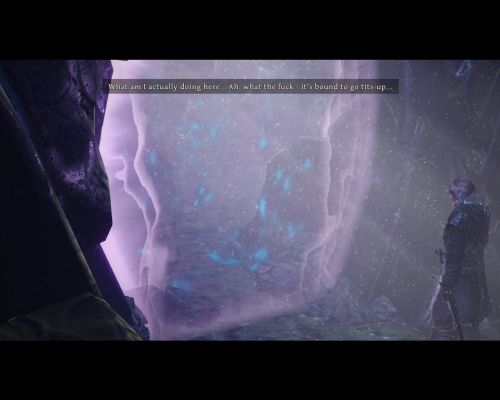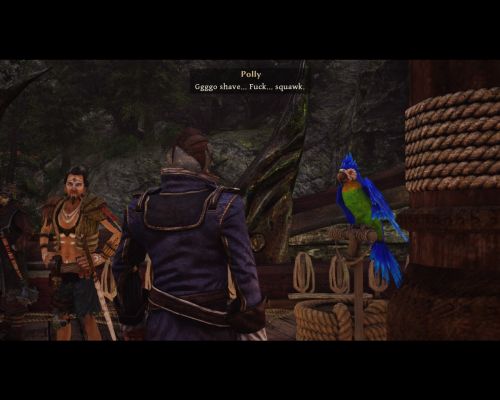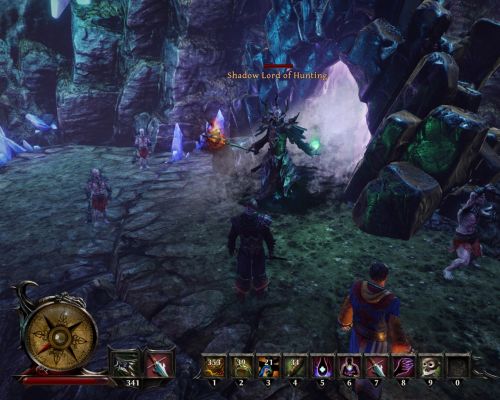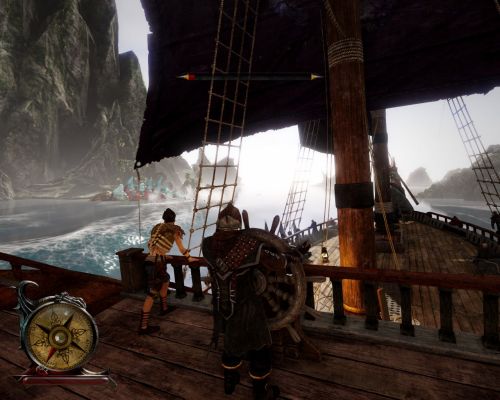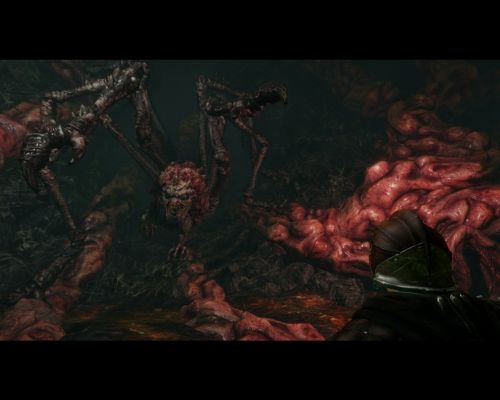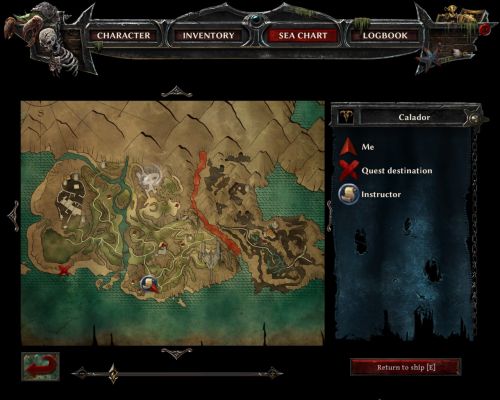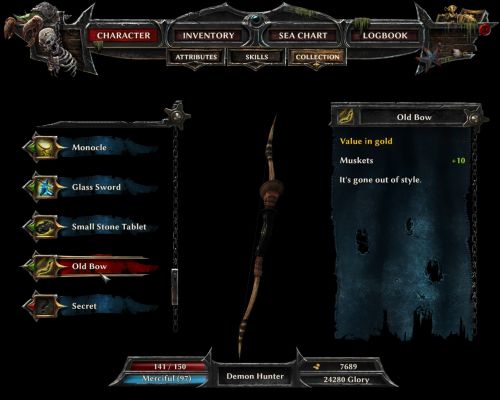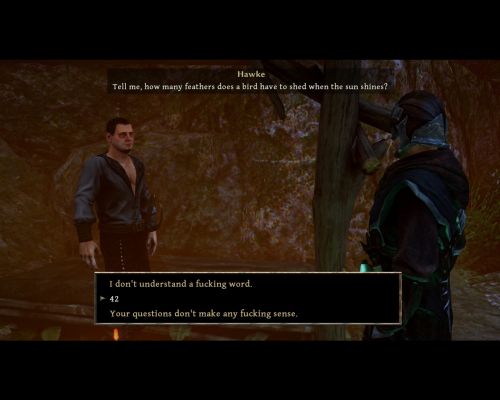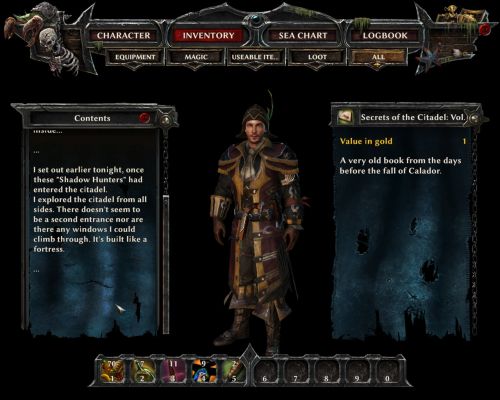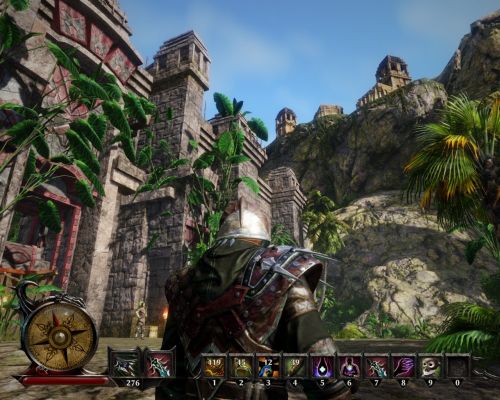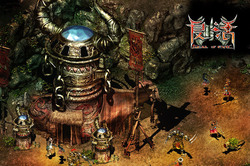RPG Codex Review: Risen 3: Titan Lords
RPG Codex Review: Risen 3: Titan Lords
Review - posted by Crooked Bee on Mon 15 September 2014, 17:58:53
Tags: Piranha Bytes; Risen 3: Titan LordsRisen 3 – Cargo Cult Cabaret
[Written by Darth Roxor; edited by Infinitron]
Piranha Bytes returns once again to deliver yet another open-world action RPG loosely following their standard formula, as established all those years ago by Gothic. As you may remember, I rather disliked Risen 2, and from the looks of it, so did a lot of other people. For Risen 3, the German developers decided to take a step back and rethink their approach in order to appease the angry fans of their previous games.
Before Risen 3 was released, a grand hype campaign was launched, where Piranha Bytes repeatedly stated that Ris3n would be closer to R1sen than Ri2en. They listed all the oldschool design formulas they wanted to return to, and promised that this time, their new game would have a proper open world, proper timing-based combat, proper difficulty, etc. I was fairly sceptical of this after the disaster that was Risen 2, especially since many of these press releases contained some rather suspicious information. Nevertheless, I decided to try and leave my prejudices behind, and dove into their latest creation to investigate whether piranhas are learning animals.
Same Ol’ Situation
Risen 3 introduces a different protagonist and picks up during an unspecified time after Risen 2. Instead of the Nameless Hero, you’ll get to play another Nameless Hero, but this time he’s the son of the pirate captain Steelbeard and the brother of Patty, two recurring characters from the Risen series. For some reason, the entire titan invasion, you know, the global apocalypse shtick, has been swept completely under the rug, and instead, the world now faces an onslaught of “shadow creatures”. The story begins when you and Patty go on a treasure hunt that actually turns out to be a trap, resulting in a Shadow Lord cutscene-killing your hapless protag and stealing his soul. Patty is mysteriously spared (haha, I’m kidding, there’s no mystery, it’s just a plot hole) and buries you in a shallow grave. But three weeks later you are resurrected by Bones, another character from Risen 2, and you must embark on a harrowing journey to get your spirit back.
The story is actually quite magnificently idiotic, but I’ll return to that in a later chapter. For now, let me tell you about the game’s character system.
There’s not much to say about the basics, really, as they are ported nearly 1:1 from Risen 2, just with a few additional skill categories (including, but not limited to, three schools of magic, crossbows and slashing weapons, which encompass maces). You have a few primary attributes that you can increase using experience, and a bunch of sub-skills vaguely connected to said attributes that you need to learn from teachers. Once again, everything is placed inside those dreadful list-menus. In this regard, Risen 3 retains all the terrible parts of its predecessor, and doesn’t really fix any of them.
Probably the biggest deal-breaker is how little tangible character progression there is because of the combination of curved XP costs and linear stat gains. When you had 40 skill points in Gothic, and you put 20 of them in strength and 20 in whatever melee skill, your increase in power was almost immediately noticeable because of how the raw damage, weapon stat requirement and critical hit systems intertwined. Meanwhile, in Risen 3, if you spend 2k xp to bring your Melee attribute from 20 to 25, not only is there no perceptible difference whatsoever, but the effect is also completely the same as if you increased it from 80 to 85, except that in the latter case the upgrade would cost a whopping 15k xp. Increasing your attributes in this game simply takes forever, and barely ever do you get the feeling that you’re getting better at something. And yet, despite these insane levelling costs, gaming the system to maximize all stats and become the ultimate fightermagethief is still more than possible, thanks to the cartloads of stat-raising plants you can find.
The gear progression is just as bad as the character progression. The number of good weapons you can find in the game is so low that I only changed my sword about three times during the whole game. All the armour, including the “ultimate” set, offers no actual protection whatsoever, and resistances are mostly gained through levelling Toughness. As for sidearms, while you are showered with various pistols throughout the entire game, I only found a whopping two crossbows, the better of which was available after some 5 hours of playing. Just about the only cool thing about weapons in this game is that you can upgrade some of them using the forge and the right ingredients.
I find it hard to explain, but it just feels as if advancement in this game was worth absolutely nothing. Yet somehow, at a certain point in the game, both of the terrible progression arcs met, and everything took a 180 degree turn. I started noticing a difference in both damage dealt and received when my Melee and Toughness attributes were upped to over 70 and I got the best armour and weapons in the game. At that point, I realised that my character had been transformed from a pushover into an unstoppable engine of doom, with no “middle state” of any kind.
The legacy of Risen 2 also rears its ugly head when it comes to the game's magic system, though not in the way you'd expect. Risen 2's system was rather low-magic - there was no mana, and the voodoo alone couldn’t carry you through combat. In contrast, Risen 3 once again allows you to call down firestorms, magic shields and force projectiles to nuke your enemies and protect your bacon. But all of these spells don’t use mana either! There is no magical resource to spend, nor are there any stat requirements on spells - the only restriction on spellcasting is cooldowns. But besides the fact that you can now pre-buff before and heal after every single fight with no repercussions whatsoever, some of the game's spells are also downright broken, like the magic shield spell Runeskin that might as well be called IDDQD. It’s also annoying as hell that the spells don’t have any numerical values in their descriptions. For example, the description of the Runeskin rune only says that the magic “shields” you. Okay, but for how long, how much, from what damage, in what way?
The game also has some psychic kung-fu spells that act as “weapons” which go into your sword hand – they hit multiple foes, have the range of a pistol, can be chained into combos and operate neither on ammo/mana nor on cooldowns. Can anyone point me to any reason why you’d want to use any weapon other than this?
The character system retains just about all the other absurdities of Risen 2, such as Alchemy governing the potency of all potions (both found and brewed), but I don’t think I have to write about all that again.
Two additions to the system were touted heavily before release, as they tied in with the character’s spiritless state – the astral vision and the humanity meter.
The astral vision feature was described rather vaguely, so I assumed it was going to be a glorified quest compass, but it turned out to be something different. Since the game has its own quest compass to begin with, the astral vision was designed as a general “stuff” detector. You can get a bunch of skills that highlight everything you want in the astral, piercing through walls and terrain – loot, demons, weapons, living creatures, etc. I found it to be mostly pointless, except for one very annoying exception. Some NPCs in Risen 3 happen to carry around unique loot, mostly crafting formulas, that I believe can’t be found anywhere else (and also can’t be stolen or bought from them). This means that unless you want to knock out every person you see in your search for the Potion of Blades formula, you have to inspect everyone for the astral loot tint... and then knock them out. Which usually turns half the settlement hostile, but eh, no problem, all the NPCs are immortal and forget their grudges after you sleep for a day because they are such friendly chaps.
Now, the humanity meter. Saying that it’s been shoehorned into the game is being generous. It ranges from 0 to 100, you start with 50, and it essentially acts like the most stereotypical Bioware alignment system you could think of. Refuse to buy a woman a drink in a tavern? SOUL -1! Tell a guy that casualties during wartime are unfortunately inevitable? SOUL -1! Keep up a corny and cheerful personality, and refuse quest rewards? SOUL+++. Good news is that the soul meter doesn’t actually change anything of worth in the game, so you don’t have to act in idiotic ways to appease it. It doesn’t block or unlock any options (even though that was promised in pre-release interviews) nor does it grant any stat boosts. It only changes the one minute-long ending cutscene, spawns an additional shadow lord on every island if you are evil (which is laughable), and makes one out of two humanity-specific companions leave you depending on where you stand.
Massive Killing Capacity
Combat has always been an important part of Piranha Bytes games. Sometimes it was better, sometimes it was worse. The developers promised that timing-based combat would be back in Risen 3, as well as a few other general improvements, mostly to difficulty and enemy variety. Let's see how that ended up.
There are, indeed, a few tweaks and fixes that make the combat system’s basic mechanics slightly better than in Risen 2. Timing your LMB clicks to chain combos fast is important again, and the combat feels much more fluid and less clunky overall. You are also very much forced to get a good grip of the riposte ability to defeat some of the stronger opponents for at least half of the game. Unfortunately, this is where the improvements end, and where Risen 2 comes back with a vengeance.
For starters, the enemy variety. Risen 3 teases you very effectively with its initial tutorial island, which probably has more enemy types than the entirety of Risen 2. But the thing is, as the game goes on, hardly any new enemies are introduced, even though the game features six different islands with distinct themes, the result of which is that even after 20 hours of gameplay, you’ll still be smacking scavengers, skeletons and spiders. What’s even worse is the amount of reskinning going on here – you know something is wrong when the “ghoul”, “black ghoul” and “water lizard” all share the exact same model, stats, sounds and animations, and differ only in their texture. The same is true for forest/rock/jungle spiders, a variety of golems, and a bunch of other creatures. Hell, even the goddamn final boss is a reskin, which was already lame in Gothic 2, and is no less terrible here.
Needless to say, all this reinforces that feeling of pointless grinding that is so pervasive in this game – it simply feels like you are just doing the same things over and over and over again, with nothing significantly new ever appearing. Once you’ve gone through one big island, you’ve seen almost everything this game has to offer. Imagine playing Knights of the Old Republic with no level scaling, where every planet is populated with the same regular cannon fodder Sith troopers, and you’ll have a good picture of Risen 3. Some of these areas are particularly insulting even still, like the voodoo-themed island of Kila, which I can only describe as a spider genocide simulator. A terrible place that throws waves of trash mob spiders in your face all the fucking time and never really stops.
And to make matters worse, fighting all of these enemies simply isn’t fun, either. Not only are the trademarked Piranha Bytes stunlocks still alive and kicking, degrading most fights to a contest of “who attacked first”, but the monsters also act very gentlemanly, stepping aside to let you clobber their bros 1v1, unless you push them up against a wall. Furthermore, the attack animations are composed of very fancy long-ranged pirouettes and spins and all that, which not only looks ridiculous, but also results in you traversing half the map before you kill anything, often driving you into another mob of foes along the way. No matter though, if you’re in trouble, just remember you can always gulp down some instant-use healing grog.
However, the combat becomes really infuriating when you have to go up against anything that can parry blows. Not just because the enemies can just go ahead and parry whenever they like in the middle of your perfectly-timed combo, but also because your only way of breaking their parry in melee is via a power attack that takes approximately half an hour to charge up, and leaves you completely vulnerable to attack. Have I mentioned that the power attack only breaks the parry, without doing any damage, which means you only have time to deliver one hit before the enemy parries again? It’s simply safer for your sanity to stick to spamming magic, muskets or acrossbow wrist-mounted rapid fire flechette pistol, because there’s no defence against those. These measures are also insanely powerful, allowing you to kill the toughest monsters in the game with no trouble as early as 3 hours in.
The immortal companion meatshields from Risen 2 also make a comeback, and, once again, I’m on the fence about them. On one hand, they completely defeat the entire purpose of the game, and kill what little challenge there is left. On the other hand, at least they speed up the horrible combat. It’s essentially a case of damned if you do, damned if you don’t.
Another particularly bad feature that makes a comeback from Risen 2 are the boss fight minigames. Chief among these are the naval battles against health-bloated sea monsters that spit huge balls of acid. Not only is it frustratingly hard and clunky to hit the creatures with your broadside cannons, but it’s also nearly impossible to evade their projectiles, despite the fact that your flagship seems to be exempt from all the laws of physics.
The last addition to Risen 3's combat system is the kill-cam feature. The kill-cam cutscenes are often hilariously badly animated, serve barely any purpose whatsoever, and may lead to intriguing phenomena such as stabbing a skeleton with a mace before slitting its throat.
Substitutional World
Another aspect of Risen 2 that was meant to be improved in this game was the exploration and general worldbuilding. It was promised that Risen 3 would return to the original formula of a fully open world with no restrictions and no handholding, one where it would be easy to run into trouble you can’t handle. Once again, some of those promises were certainly fulfilled, but as with everything else in Risen 3, for every step forward Piranha Bytes took, there was also at least one step back.
To start off with what was improved, the game's maps are now significantly larger, are much less corridor-like, and have more visual variety. The general world design is also better and more believable, with more caves and ruins to explore, and a generally higher amount of things to do. As promised, it is also very easy to stumble upon strong enemies from the get-go, although this is no longer as exciting as it was in the original Gothics because of the terrible combat and generally low difficulty level.
What I would consider the best and most important improvement in this game is making climbing much less obnoxious than it was in Risen 2. Secret areas are much better hidden now, with the ledges leading to them no longer as glaringly conspicuous, and the climbing animations have been significantly shortened, which means that looking around for hidden goodies can actually be fun again. You might even find stuff that you hadn’t noticed earlier when travelling through an area for the second time. One thing that I noticed is used too often, however, is the placement of items on top of houses - almost every other building will have gold on its roof for some inexplicable reason. It’s also rather lame that every secret hiding place that can only be accessed via trained monkey has the glaring ‘here be monkey business!’ sign in the form of two neutral monkeys running around it.
And yet, Risen 3 retains the most awful flaw of its predecessor. Despite the areas being more open and the secrets less glaringly obvious, the exploration is still neither fun, nor particularly rewarding. This comes mostly as a consequence of four major flaws in its overall design. The first of these is the god-awful enemy variety and progression mechanics that I mentioned earlier.
The second big flaw also comes straight from Risen 2 – the locked chests. Once again, chests can only be opened if you meet the lockpicking requirement, once again they have the pointless unbreakable lockpick minigame, and once again they contain nothing but junk. The skill requirements range from 10 to 120, and the chests only start giving you anything worth a damn at 90+, but even then it’s mostly gold and trinkets, with very, very few unique items. Although it has to be said that at least this time PB tried to ease up on the skill reqs by providing alternative ways of opening the chests – mages get a Rust spell that replaces lockpicking, and you can also brew Thief’s Potions that give you a short lockpicking and pickpocketing boost. Not to mention that magic jewellery that increases skills is ubiquitous, so getting a pickpocketing +30 boost is more than possible. But none of that changes the fact that it’s still infuriating to find a cleverly hidden secret place or fight through hordes of monsters just to end it all with a chest locked to 120, then return there after 10 hours with sufficiently increased lockpicking skills and realise the bloody thing contains 250 gold and two worthless gems.
And that brings us to the third flaw that kills Risen 3’s exploration – the maps. Because the areas are more open than in Risen 2, it’s much harder to remember where you found locked chests in the past. This would be easily solved if you could leave custom map markers...but you can’t. That’s a small fry, though, compared to the game's biggest stinker – all maps are fully uncovered when you arrive in a new area. This kills all sense of discovery, because a short glance at the map will show you everything there is to find in the region, including caves and ruins. And ignoring the map is just not possible because you often find treasure maps or books about unique items that give you no directions whatsoever, meaning they can only be found via quest compass – though at least NPCs usually give proper directions towards quest objectives. All those hidden treasures and items are kind of a pain in the ass, by the way, because you can’t find most of them on your own, and they're often located on other islands. This means that you are constantly being sent back and forth between places you’ve already been to. Now combine that with the fact that all those treasures are usually located in the ass-ends of the islands, that there are no speed potions, and that the game's teleport waypoints are often placed in terrible locations, and you have a recipe for disaster.
The final and largest of the four flaws are the invisible walls. Yes, literal invisible walls that actually teleport you back or stop you in your tracks. The most glaring and idiotic example of this can be found on the island called Calador. One part of the island is separated from the mainland by a stream of lava, and was once linked to it by a stone bridge. But now the bridge is broken and there is no way across!...except, you know, swimming ashore. Or using a “parrot flight” spell that morphs you into a smug parrot which lets you fly around, traverse chasms and access high-placed vantage points. But neither of these work. First, swimming, whose return to the game was very loudly touted, is not possible, because approaching the secluded part’s shore just teleports you back where you started. Now, the parrot flight. This spell isn’t even some sort of super-secret exploit - even common people in the game refer to it pretty often. So, Jesus Christ jumping on a pogo stick, why won’t the demon hunters and druids who want to cross that goddamn bridge just use that friggin’ spell and be done with it? And why can’t you do that? Why does morphing into a parrot and flying over the bridge make you smash into an invisible wall, and why does jumping into the lava teleport you back unharmed? This sort of "design" is used a few more times in places where the developers simply didn’t want you to be before advancing the plot. It is completely fucking stupid, and further violates any internal logic the game could have. You're also teleported during certain obligatory ominous dream sequences that serve little actual purpose story and gameplay-wise. Walking off the One True Path sends you instantly back to the start, with the protagonist saying ‘I still have something to do here!’. Subtle.
Internal logic is generally in rather short supply in this game. It's clear that not much thought thought has been invested into some of its quests and areas. For example, a dude who tells you that he’s just cleared out a cave of monsters, even though it’s still crawling with them; an “old bow” that for some inexplicable reason gives you a +10 to muskets; a citadel of druids where you meet only one actual druid... and the list goes on. But I think the experience that most defined Risen 3 for me was as follows: The game has these one-time pop-up hints that show up when you encounter something new. At one point in the game, a hint popped up saying “press LMB to open doors”. It was then that I realised that despite that fact that I’d been playing the game for 15 hours and had gone through three islands worth of various farms and settlements, I’d never stumbled upon a single door before, be it closed, open or even non-interactive prop.
Closet Chronicles
As I said at the beginning of the review, there's plenty to say about Risen 3’s narrative and quest design.
To begin with, let’s address the topic of the game's overall storyline. I could only describe it as a non-stop rollercoaster of ass pulls. Your protagonist has never existed before, he is put in the middle of events coming out of nowhere, he survives what is essentially demonification for no apparent reason, various characters from across the series appear completely randomly everywhere, and their motivations and personalities also change in various ways because...just because.
The whole idea of changing the protagonist is one of the most puzzling aspects of this game. You start the game among familiar faces, you meet dead people from Risen 1 and 2 to which you have no connection, you are haunted by the raging ghost of Risen 2’s pirate captain Crow without any explanation as to why, and soon enough you assemble a crew... made up at least in half of the crew from Risen 2. The entire storyline seems like it was written for the original Risen protagonist at first, but then someone had the brilliant idea of changing the main character, while introducing only the flimsiest of band-aid fixes to the script.
Not to mention how utterly lame and half-arsed everything feels. Why bring back the most boring pirate captain from Risen 2? Why introduce a whole new threat of shadow creatures instead of developing the titan invasion angle? You actually don’t hear any concrete information about the titans up until some 20 hours (out of my 25h total playtime) into the game, despite the game being called Titan Lords, and the way they “tie” into the shadow invasion also has “last-minute band-aid ass pull” splattered all over it.
Also, it’s sad how tremendous of a nosedive Piranha Bytes' writing quality has taken. The writing and pirate stylisation were Risen 2’s only saving graces, but in Risen 3 the dialogues and narrative are simply abysmal. This is not just because the dialogues are badly written overall, but also because they lack any sort of flair or general direction, which the writers apparently tried to hide under an endless stream of gratuitous vulgarisms. The protagonist keeps slinging out “fucks” as if he was from downtown London, and the other characters are happy to return the favour. Additionally, almost no effort has been invested into the dialogues of the trainers who teach you new abilities. It’s not uncommon to witness a marvelous conversation along the lines of “teach me how to eat raw meat” -> ‘OK!’ or “teach me how to do magic!” -> “OK YOU CAN NOW DO MAGIX!”.
The game seems like it's trying to craft some sort of bizarre fusion of ideas from across PB’s catalogue on its islands – Calador kind of resembles Gothic 2 in its gritty medieval style, Taranis is a throwback to Risen 1’s inquisition and mages, Kila and Antigua are all about voodoo and pirates, and the returning Tacarigua brings back the “colonial” inquisition from Risen 2. It’s just schizophrenic, like a theme park of unrelated concepts and leftover ideas fused into one.
The quest design is also terrible, to the point where I could say there’s hardly any quest design at all. When you think about previous Piranha Bytes games, you're likely to recall that most of their early chapters took place in cities. There, you’d do some busywork, get better gear, and barely ever actually brandish out your weapon. The cities were big, with interesting enough quests that you’d gain a few level-ups before having to venture into the deadly wilderness. But in Risen 3, there are no cities. At best, you could call them “settlements” - they're small as hell, they barely have any non-violent quests, and their inhabitants' favourite activity is to send you out towards the most dangerous creatures on the island.
The aforementioned “quest” “design” means Risen 3’s difficulty curve is completely bonkers. There is almost nothing to do inside its towns, which means you immediately have to go out and start genociding the local fauna. Remember when I said the entire game feels like a pointless grind? This is the last nail in its coffin. Just try to gather everything I’ve written about the game so far and put it into this one awful picture – terrible enemy variety, lacklustre exploration, assignments that send you back and forth, and very little time spent on quests in towns. Town quests have always been a staple of Piranha Bytes’ games! Even Risen 2 still sort of retained the formula of quests that could be solved in a variety of ways (steal, sweet talk, beat up, use voodoo or the monkey), and actually did shine a bit in those places that had lots of them, like Caldera. Meanwhile, Risen 3 simply throws that formula out the window.
Finally, I should probably address the return of the faction system. Risen 2 only had the choice between the natives and the inquisition, which was actually important gameplay-wise because it was essentially a choice between guns and magic (not to mention that doing random shit with possessed people was hilarious). Risen 3 on the other hand, lets you choose from three factions – demon hunters, mages and voodoo pirates. Sounds like a decent choice between warriors, spellcasters and rogues, right? Well, think again.
Fact is, the faction choice is so fake it’s not even funny. This is not just because every faction seems to have only one unique quest, but also due to the fact that your choice of faction only provides cosmetic dialogue choices and reactivity, with miniscule impact on character building. There are no faction-based limitations placed on thievery, crafting, melee combat or ranged combat. Every faction has its own type of magic, and while the spells are different in some ways, they still mostly fall under the schemata of nukes/heals/buffs. This means that no matter which “path” you take, you’ll still end up as a fightermagethief extraordinaire.
New Coat of Paint
The overall presentation in Risen 3 is a significant step up from Risen 2. It uses the same engine as its predecessor, but the art direction is much better – the various areas in the game now feel much more distinct from each in layout and style, and no longer does every island feel like a Generic_Tropical_Paradise. Also, I was quite positively surprised to see that the engine supports 5:4 resolutions in this day and age. The game definitely overuses certain eye-gouging bloom tints in many places, though. It’s also quite jarring how most of the recurring characters from the previous games don’t resemble their earlier models at all, which leads me to believe that they travel with a personal entourage of plastic surgeons.
Audio-wise, there’s not much to talk about. Most of the sound effects are recycled, while the music is minimalistic, though actually fairly good despite the lack of Kai Rosenkranz. Voice acting is competent overall, just like in the previous games, but with one very big exception. The guy voicing the protagonist is simply terrible, and considering that you have to listen to him for the entire game, that’s one massively annoying flaw. Community member Angthoron described him as being “like Nolan's Batman with a sore throat after eating Geralt”, and try as I might, I can’t find any description that would fit better.
On a positive note, Risen 3 is generally very well optimised and polished. It ran smoothly on my PC, I never had any crashes, and my playthrough was almost completely bug-free. The only two abnormalities I ran across were typical Risen engine physics shenanigans where killed enemies would suddenly skyrocket, and broken NPC schedules that wouldn’t trigger properly after resting until specific times of the day.
On the flipside, the game suffers from some seriously bad production values when it comes to cutscenes and scripted events. They are really badly animated, their voiceovers are often out of sync, they end abruptly, and generally they look like they were slapped together with minimal effort.
A Bellyful of Emptiness
To sum up my final impression of both Risen 3 and Piranha Bytes as a whole, I’d like to quote my very good friend Boethius:
That is the state of Piranha Bytes today, in a nutshell. They know that they must return to the old Gothic formula, and hell, they probably even want to do it, but they simply have no idea how. They grasp at the ideas and elements that were present in their most successful games, they announce that they are "going back to the roots", and they even attempt to fix the flaws that they've introduced, but they are not able to put those changes and fixes into proper context, nor design the same systems that once made them great. Thus, the final product is but a warped shadow of its original counterpart, a haphazardly glued-together Frankenstein’s monster that might be made of similar flesh, but can never be even one tenth as functional or “alive”.
Unfortunately, I doubt they will ever reach their past greatness again. This is made apparent both by the quality of their last two games, and by comparing the credits of Gothic 2 and Risen 3. Hell, even comparing Risen 1 to Risen 3 should be enough to draw the necessary conclusions.
[Written by Darth Roxor; edited by Infinitron]
Piranha Bytes returns once again to deliver yet another open-world action RPG loosely following their standard formula, as established all those years ago by Gothic. As you may remember, I rather disliked Risen 2, and from the looks of it, so did a lot of other people. For Risen 3, the German developers decided to take a step back and rethink their approach in order to appease the angry fans of their previous games.
Before Risen 3 was released, a grand hype campaign was launched, where Piranha Bytes repeatedly stated that Ris3n would be closer to R1sen than Ri2en. They listed all the oldschool design formulas they wanted to return to, and promised that this time, their new game would have a proper open world, proper timing-based combat, proper difficulty, etc. I was fairly sceptical of this after the disaster that was Risen 2, especially since many of these press releases contained some rather suspicious information. Nevertheless, I decided to try and leave my prejudices behind, and dove into their latest creation to investigate whether piranhas are learning animals.
Same Ol’ Situation
Risen 3 introduces a different protagonist and picks up during an unspecified time after Risen 2. Instead of the Nameless Hero, you’ll get to play another Nameless Hero, but this time he’s the son of the pirate captain Steelbeard and the brother of Patty, two recurring characters from the Risen series. For some reason, the entire titan invasion, you know, the global apocalypse shtick, has been swept completely under the rug, and instead, the world now faces an onslaught of “shadow creatures”. The story begins when you and Patty go on a treasure hunt that actually turns out to be a trap, resulting in a Shadow Lord cutscene-killing your hapless protag and stealing his soul. Patty is mysteriously spared (haha, I’m kidding, there’s no mystery, it’s just a plot hole) and buries you in a shallow grave. But three weeks later you are resurrected by Bones, another character from Risen 2, and you must embark on a harrowing journey to get your spirit back.
The story is actually quite magnificently idiotic, but I’ll return to that in a later chapter. For now, let me tell you about the game’s character system.
There’s not much to say about the basics, really, as they are ported nearly 1:1 from Risen 2, just with a few additional skill categories (including, but not limited to, three schools of magic, crossbows and slashing weapons, which encompass maces). You have a few primary attributes that you can increase using experience, and a bunch of sub-skills vaguely connected to said attributes that you need to learn from teachers. Once again, everything is placed inside those dreadful list-menus. In this regard, Risen 3 retains all the terrible parts of its predecessor, and doesn’t really fix any of them.
Probably the biggest deal-breaker is how little tangible character progression there is because of the combination of curved XP costs and linear stat gains. When you had 40 skill points in Gothic, and you put 20 of them in strength and 20 in whatever melee skill, your increase in power was almost immediately noticeable because of how the raw damage, weapon stat requirement and critical hit systems intertwined. Meanwhile, in Risen 3, if you spend 2k xp to bring your Melee attribute from 20 to 25, not only is there no perceptible difference whatsoever, but the effect is also completely the same as if you increased it from 80 to 85, except that in the latter case the upgrade would cost a whopping 15k xp. Increasing your attributes in this game simply takes forever, and barely ever do you get the feeling that you’re getting better at something. And yet, despite these insane levelling costs, gaming the system to maximize all stats and become the ultimate fightermagethief is still more than possible, thanks to the cartloads of stat-raising plants you can find.
The gear progression is just as bad as the character progression. The number of good weapons you can find in the game is so low that I only changed my sword about three times during the whole game. All the armour, including the “ultimate” set, offers no actual protection whatsoever, and resistances are mostly gained through levelling Toughness. As for sidearms, while you are showered with various pistols throughout the entire game, I only found a whopping two crossbows, the better of which was available after some 5 hours of playing. Just about the only cool thing about weapons in this game is that you can upgrade some of them using the forge and the right ingredients.
I find it hard to explain, but it just feels as if advancement in this game was worth absolutely nothing. Yet somehow, at a certain point in the game, both of the terrible progression arcs met, and everything took a 180 degree turn. I started noticing a difference in both damage dealt and received when my Melee and Toughness attributes were upped to over 70 and I got the best armour and weapons in the game. At that point, I realised that my character had been transformed from a pushover into an unstoppable engine of doom, with no “middle state” of any kind.
The legacy of Risen 2 also rears its ugly head when it comes to the game's magic system, though not in the way you'd expect. Risen 2's system was rather low-magic - there was no mana, and the voodoo alone couldn’t carry you through combat. In contrast, Risen 3 once again allows you to call down firestorms, magic shields and force projectiles to nuke your enemies and protect your bacon. But all of these spells don’t use mana either! There is no magical resource to spend, nor are there any stat requirements on spells - the only restriction on spellcasting is cooldowns. But besides the fact that you can now pre-buff before and heal after every single fight with no repercussions whatsoever, some of the game's spells are also downright broken, like the magic shield spell Runeskin that might as well be called IDDQD. It’s also annoying as hell that the spells don’t have any numerical values in their descriptions. For example, the description of the Runeskin rune only says that the magic “shields” you. Okay, but for how long, how much, from what damage, in what way?
The game also has some psychic kung-fu spells that act as “weapons” which go into your sword hand – they hit multiple foes, have the range of a pistol, can be chained into combos and operate neither on ammo/mana nor on cooldowns. Can anyone point me to any reason why you’d want to use any weapon other than this?
The character system retains just about all the other absurdities of Risen 2, such as Alchemy governing the potency of all potions (both found and brewed), but I don’t think I have to write about all that again.
Two additions to the system were touted heavily before release, as they tied in with the character’s spiritless state – the astral vision and the humanity meter.
The astral vision feature was described rather vaguely, so I assumed it was going to be a glorified quest compass, but it turned out to be something different. Since the game has its own quest compass to begin with, the astral vision was designed as a general “stuff” detector. You can get a bunch of skills that highlight everything you want in the astral, piercing through walls and terrain – loot, demons, weapons, living creatures, etc. I found it to be mostly pointless, except for one very annoying exception. Some NPCs in Risen 3 happen to carry around unique loot, mostly crafting formulas, that I believe can’t be found anywhere else (and also can’t be stolen or bought from them). This means that unless you want to knock out every person you see in your search for the Potion of Blades formula, you have to inspect everyone for the astral loot tint... and then knock them out. Which usually turns half the settlement hostile, but eh, no problem, all the NPCs are immortal and forget their grudges after you sleep for a day because they are such friendly chaps.
Now, the humanity meter. Saying that it’s been shoehorned into the game is being generous. It ranges from 0 to 100, you start with 50, and it essentially acts like the most stereotypical Bioware alignment system you could think of. Refuse to buy a woman a drink in a tavern? SOUL -1! Tell a guy that casualties during wartime are unfortunately inevitable? SOUL -1! Keep up a corny and cheerful personality, and refuse quest rewards? SOUL+++. Good news is that the soul meter doesn’t actually change anything of worth in the game, so you don’t have to act in idiotic ways to appease it. It doesn’t block or unlock any options (even though that was promised in pre-release interviews) nor does it grant any stat boosts. It only changes the one minute-long ending cutscene, spawns an additional shadow lord on every island if you are evil (which is laughable), and makes one out of two humanity-specific companions leave you depending on where you stand.
Massive Killing Capacity
Combat has always been an important part of Piranha Bytes games. Sometimes it was better, sometimes it was worse. The developers promised that timing-based combat would be back in Risen 3, as well as a few other general improvements, mostly to difficulty and enemy variety. Let's see how that ended up.
There are, indeed, a few tweaks and fixes that make the combat system’s basic mechanics slightly better than in Risen 2. Timing your LMB clicks to chain combos fast is important again, and the combat feels much more fluid and less clunky overall. You are also very much forced to get a good grip of the riposte ability to defeat some of the stronger opponents for at least half of the game. Unfortunately, this is where the improvements end, and where Risen 2 comes back with a vengeance.
For starters, the enemy variety. Risen 3 teases you very effectively with its initial tutorial island, which probably has more enemy types than the entirety of Risen 2. But the thing is, as the game goes on, hardly any new enemies are introduced, even though the game features six different islands with distinct themes, the result of which is that even after 20 hours of gameplay, you’ll still be smacking scavengers, skeletons and spiders. What’s even worse is the amount of reskinning going on here – you know something is wrong when the “ghoul”, “black ghoul” and “water lizard” all share the exact same model, stats, sounds and animations, and differ only in their texture. The same is true for forest/rock/jungle spiders, a variety of golems, and a bunch of other creatures. Hell, even the goddamn final boss is a reskin, which was already lame in Gothic 2, and is no less terrible here.
Needless to say, all this reinforces that feeling of pointless grinding that is so pervasive in this game – it simply feels like you are just doing the same things over and over and over again, with nothing significantly new ever appearing. Once you’ve gone through one big island, you’ve seen almost everything this game has to offer. Imagine playing Knights of the Old Republic with no level scaling, where every planet is populated with the same regular cannon fodder Sith troopers, and you’ll have a good picture of Risen 3. Some of these areas are particularly insulting even still, like the voodoo-themed island of Kila, which I can only describe as a spider genocide simulator. A terrible place that throws waves of trash mob spiders in your face all the fucking time and never really stops.
And to make matters worse, fighting all of these enemies simply isn’t fun, either. Not only are the trademarked Piranha Bytes stunlocks still alive and kicking, degrading most fights to a contest of “who attacked first”, but the monsters also act very gentlemanly, stepping aside to let you clobber their bros 1v1, unless you push them up against a wall. Furthermore, the attack animations are composed of very fancy long-ranged pirouettes and spins and all that, which not only looks ridiculous, but also results in you traversing half the map before you kill anything, often driving you into another mob of foes along the way. No matter though, if you’re in trouble, just remember you can always gulp down some instant-use healing grog.
However, the combat becomes really infuriating when you have to go up against anything that can parry blows. Not just because the enemies can just go ahead and parry whenever they like in the middle of your perfectly-timed combo, but also because your only way of breaking their parry in melee is via a power attack that takes approximately half an hour to charge up, and leaves you completely vulnerable to attack. Have I mentioned that the power attack only breaks the parry, without doing any damage, which means you only have time to deliver one hit before the enemy parries again? It’s simply safer for your sanity to stick to spamming magic, muskets or a
The immortal companion meatshields from Risen 2 also make a comeback, and, once again, I’m on the fence about them. On one hand, they completely defeat the entire purpose of the game, and kill what little challenge there is left. On the other hand, at least they speed up the horrible combat. It’s essentially a case of damned if you do, damned if you don’t.
Another particularly bad feature that makes a comeback from Risen 2 are the boss fight minigames. Chief among these are the naval battles against health-bloated sea monsters that spit huge balls of acid. Not only is it frustratingly hard and clunky to hit the creatures with your broadside cannons, but it’s also nearly impossible to evade their projectiles, despite the fact that your flagship seems to be exempt from all the laws of physics.
The last addition to Risen 3's combat system is the kill-cam feature. The kill-cam cutscenes are often hilariously badly animated, serve barely any purpose whatsoever, and may lead to intriguing phenomena such as stabbing a skeleton with a mace before slitting its throat.
Substitutional World
Another aspect of Risen 2 that was meant to be improved in this game was the exploration and general worldbuilding. It was promised that Risen 3 would return to the original formula of a fully open world with no restrictions and no handholding, one where it would be easy to run into trouble you can’t handle. Once again, some of those promises were certainly fulfilled, but as with everything else in Risen 3, for every step forward Piranha Bytes took, there was also at least one step back.
To start off with what was improved, the game's maps are now significantly larger, are much less corridor-like, and have more visual variety. The general world design is also better and more believable, with more caves and ruins to explore, and a generally higher amount of things to do. As promised, it is also very easy to stumble upon strong enemies from the get-go, although this is no longer as exciting as it was in the original Gothics because of the terrible combat and generally low difficulty level.
What I would consider the best and most important improvement in this game is making climbing much less obnoxious than it was in Risen 2. Secret areas are much better hidden now, with the ledges leading to them no longer as glaringly conspicuous, and the climbing animations have been significantly shortened, which means that looking around for hidden goodies can actually be fun again. You might even find stuff that you hadn’t noticed earlier when travelling through an area for the second time. One thing that I noticed is used too often, however, is the placement of items on top of houses - almost every other building will have gold on its roof for some inexplicable reason. It’s also rather lame that every secret hiding place that can only be accessed via trained monkey has the glaring ‘here be monkey business!’ sign in the form of two neutral monkeys running around it.
And yet, Risen 3 retains the most awful flaw of its predecessor. Despite the areas being more open and the secrets less glaringly obvious, the exploration is still neither fun, nor particularly rewarding. This comes mostly as a consequence of four major flaws in its overall design. The first of these is the god-awful enemy variety and progression mechanics that I mentioned earlier.
The second big flaw also comes straight from Risen 2 – the locked chests. Once again, chests can only be opened if you meet the lockpicking requirement, once again they have the pointless unbreakable lockpick minigame, and once again they contain nothing but junk. The skill requirements range from 10 to 120, and the chests only start giving you anything worth a damn at 90+, but even then it’s mostly gold and trinkets, with very, very few unique items. Although it has to be said that at least this time PB tried to ease up on the skill reqs by providing alternative ways of opening the chests – mages get a Rust spell that replaces lockpicking, and you can also brew Thief’s Potions that give you a short lockpicking and pickpocketing boost. Not to mention that magic jewellery that increases skills is ubiquitous, so getting a pickpocketing +30 boost is more than possible. But none of that changes the fact that it’s still infuriating to find a cleverly hidden secret place or fight through hordes of monsters just to end it all with a chest locked to 120, then return there after 10 hours with sufficiently increased lockpicking skills and realise the bloody thing contains 250 gold and two worthless gems.
And that brings us to the third flaw that kills Risen 3’s exploration – the maps. Because the areas are more open than in Risen 2, it’s much harder to remember where you found locked chests in the past. This would be easily solved if you could leave custom map markers...but you can’t. That’s a small fry, though, compared to the game's biggest stinker – all maps are fully uncovered when you arrive in a new area. This kills all sense of discovery, because a short glance at the map will show you everything there is to find in the region, including caves and ruins. And ignoring the map is just not possible because you often find treasure maps or books about unique items that give you no directions whatsoever, meaning they can only be found via quest compass – though at least NPCs usually give proper directions towards quest objectives. All those hidden treasures and items are kind of a pain in the ass, by the way, because you can’t find most of them on your own, and they're often located on other islands. This means that you are constantly being sent back and forth between places you’ve already been to. Now combine that with the fact that all those treasures are usually located in the ass-ends of the islands, that there are no speed potions, and that the game's teleport waypoints are often placed in terrible locations, and you have a recipe for disaster.
The final and largest of the four flaws are the invisible walls. Yes, literal invisible walls that actually teleport you back or stop you in your tracks. The most glaring and idiotic example of this can be found on the island called Calador. One part of the island is separated from the mainland by a stream of lava, and was once linked to it by a stone bridge. But now the bridge is broken and there is no way across!...except, you know, swimming ashore. Or using a “parrot flight” spell that morphs you into a smug parrot which lets you fly around, traverse chasms and access high-placed vantage points. But neither of these work. First, swimming, whose return to the game was very loudly touted, is not possible, because approaching the secluded part’s shore just teleports you back where you started. Now, the parrot flight. This spell isn’t even some sort of super-secret exploit - even common people in the game refer to it pretty often. So, Jesus Christ jumping on a pogo stick, why won’t the demon hunters and druids who want to cross that goddamn bridge just use that friggin’ spell and be done with it? And why can’t you do that? Why does morphing into a parrot and flying over the bridge make you smash into an invisible wall, and why does jumping into the lava teleport you back unharmed? This sort of "design" is used a few more times in places where the developers simply didn’t want you to be before advancing the plot. It is completely fucking stupid, and further violates any internal logic the game could have. You're also teleported during certain obligatory ominous dream sequences that serve little actual purpose story and gameplay-wise. Walking off the One True Path sends you instantly back to the start, with the protagonist saying ‘I still have something to do here!’. Subtle.
Internal logic is generally in rather short supply in this game. It's clear that not much thought thought has been invested into some of its quests and areas. For example, a dude who tells you that he’s just cleared out a cave of monsters, even though it’s still crawling with them; an “old bow” that for some inexplicable reason gives you a +10 to muskets; a citadel of druids where you meet only one actual druid... and the list goes on. But I think the experience that most defined Risen 3 for me was as follows: The game has these one-time pop-up hints that show up when you encounter something new. At one point in the game, a hint popped up saying “press LMB to open doors”. It was then that I realised that despite that fact that I’d been playing the game for 15 hours and had gone through three islands worth of various farms and settlements, I’d never stumbled upon a single door before, be it closed, open or even non-interactive prop.
Closet Chronicles
As I said at the beginning of the review, there's plenty to say about Risen 3’s narrative and quest design.
To begin with, let’s address the topic of the game's overall storyline. I could only describe it as a non-stop rollercoaster of ass pulls. Your protagonist has never existed before, he is put in the middle of events coming out of nowhere, he survives what is essentially demonification for no apparent reason, various characters from across the series appear completely randomly everywhere, and their motivations and personalities also change in various ways because...just because.
The whole idea of changing the protagonist is one of the most puzzling aspects of this game. You start the game among familiar faces, you meet dead people from Risen 1 and 2 to which you have no connection, you are haunted by the raging ghost of Risen 2’s pirate captain Crow without any explanation as to why, and soon enough you assemble a crew... made up at least in half of the crew from Risen 2. The entire storyline seems like it was written for the original Risen protagonist at first, but then someone had the brilliant idea of changing the main character, while introducing only the flimsiest of band-aid fixes to the script.
Not to mention how utterly lame and half-arsed everything feels. Why bring back the most boring pirate captain from Risen 2? Why introduce a whole new threat of shadow creatures instead of developing the titan invasion angle? You actually don’t hear any concrete information about the titans up until some 20 hours (out of my 25h total playtime) into the game, despite the game being called Titan Lords, and the way they “tie” into the shadow invasion also has “last-minute band-aid ass pull” splattered all over it.
Also, it’s sad how tremendous of a nosedive Piranha Bytes' writing quality has taken. The writing and pirate stylisation were Risen 2’s only saving graces, but in Risen 3 the dialogues and narrative are simply abysmal. This is not just because the dialogues are badly written overall, but also because they lack any sort of flair or general direction, which the writers apparently tried to hide under an endless stream of gratuitous vulgarisms. The protagonist keeps slinging out “fucks” as if he was from downtown London, and the other characters are happy to return the favour. Additionally, almost no effort has been invested into the dialogues of the trainers who teach you new abilities. It’s not uncommon to witness a marvelous conversation along the lines of “teach me how to eat raw meat” -> ‘OK!’ or “teach me how to do magic!” -> “OK YOU CAN NOW DO MAGIX!”.
The game seems like it's trying to craft some sort of bizarre fusion of ideas from across PB’s catalogue on its islands – Calador kind of resembles Gothic 2 in its gritty medieval style, Taranis is a throwback to Risen 1’s inquisition and mages, Kila and Antigua are all about voodoo and pirates, and the returning Tacarigua brings back the “colonial” inquisition from Risen 2. It’s just schizophrenic, like a theme park of unrelated concepts and leftover ideas fused into one.
The quest design is also terrible, to the point where I could say there’s hardly any quest design at all. When you think about previous Piranha Bytes games, you're likely to recall that most of their early chapters took place in cities. There, you’d do some busywork, get better gear, and barely ever actually brandish out your weapon. The cities were big, with interesting enough quests that you’d gain a few level-ups before having to venture into the deadly wilderness. But in Risen 3, there are no cities. At best, you could call them “settlements” - they're small as hell, they barely have any non-violent quests, and their inhabitants' favourite activity is to send you out towards the most dangerous creatures on the island.
The aforementioned “quest” “design” means Risen 3’s difficulty curve is completely bonkers. There is almost nothing to do inside its towns, which means you immediately have to go out and start genociding the local fauna. Remember when I said the entire game feels like a pointless grind? This is the last nail in its coffin. Just try to gather everything I’ve written about the game so far and put it into this one awful picture – terrible enemy variety, lacklustre exploration, assignments that send you back and forth, and very little time spent on quests in towns. Town quests have always been a staple of Piranha Bytes’ games! Even Risen 2 still sort of retained the formula of quests that could be solved in a variety of ways (steal, sweet talk, beat up, use voodoo or the monkey), and actually did shine a bit in those places that had lots of them, like Caldera. Meanwhile, Risen 3 simply throws that formula out the window.
Finally, I should probably address the return of the faction system. Risen 2 only had the choice between the natives and the inquisition, which was actually important gameplay-wise because it was essentially a choice between guns and magic (not to mention that doing random shit with possessed people was hilarious). Risen 3 on the other hand, lets you choose from three factions – demon hunters, mages and voodoo pirates. Sounds like a decent choice between warriors, spellcasters and rogues, right? Well, think again.
Fact is, the faction choice is so fake it’s not even funny. This is not just because every faction seems to have only one unique quest, but also due to the fact that your choice of faction only provides cosmetic dialogue choices and reactivity, with miniscule impact on character building. There are no faction-based limitations placed on thievery, crafting, melee combat or ranged combat. Every faction has its own type of magic, and while the spells are different in some ways, they still mostly fall under the schemata of nukes/heals/buffs. This means that no matter which “path” you take, you’ll still end up as a fightermagethief extraordinaire.
New Coat of Paint
The overall presentation in Risen 3 is a significant step up from Risen 2. It uses the same engine as its predecessor, but the art direction is much better – the various areas in the game now feel much more distinct from each in layout and style, and no longer does every island feel like a Generic_Tropical_Paradise. Also, I was quite positively surprised to see that the engine supports 5:4 resolutions in this day and age. The game definitely overuses certain eye-gouging bloom tints in many places, though. It’s also quite jarring how most of the recurring characters from the previous games don’t resemble their earlier models at all, which leads me to believe that they travel with a personal entourage of plastic surgeons.
Audio-wise, there’s not much to talk about. Most of the sound effects are recycled, while the music is minimalistic, though actually fairly good despite the lack of Kai Rosenkranz. Voice acting is competent overall, just like in the previous games, but with one very big exception. The guy voicing the protagonist is simply terrible, and considering that you have to listen to him for the entire game, that’s one massively annoying flaw. Community member Angthoron described him as being “like Nolan's Batman with a sore throat after eating Geralt”, and try as I might, I can’t find any description that would fit better.
On a positive note, Risen 3 is generally very well optimised and polished. It ran smoothly on my PC, I never had any crashes, and my playthrough was almost completely bug-free. The only two abnormalities I ran across were typical Risen engine physics shenanigans where killed enemies would suddenly skyrocket, and broken NPC schedules that wouldn’t trigger properly after resting until specific times of the day.
On the flipside, the game suffers from some seriously bad production values when it comes to cutscenes and scripted events. They are really badly animated, their voiceovers are often out of sync, they end abruptly, and generally they look like they were slapped together with minimal effort.
A Bellyful of Emptiness
To sum up my final impression of both Risen 3 and Piranha Bytes as a whole, I’d like to quote my very good friend Boethius:
But we will still speak concerning the nature of men, and concerning their pursuits. Though, then, their mind and their nature be now dimmed, and they are by that fall sunk down to evil, and thither inclined, yet they are desirous, so far as they can and may, of the highest good. As a drunken man knows that he should go to his house, and to his rest, and yet is not able to find the way thither, so is it also with the mind, when it is weighed down by the anxieties of this world.
That is the state of Piranha Bytes today, in a nutshell. They know that they must return to the old Gothic formula, and hell, they probably even want to do it, but they simply have no idea how. They grasp at the ideas and elements that were present in their most successful games, they announce that they are "going back to the roots", and they even attempt to fix the flaws that they've introduced, but they are not able to put those changes and fixes into proper context, nor design the same systems that once made them great. Thus, the final product is but a warped shadow of its original counterpart, a haphazardly glued-together Frankenstein’s monster that might be made of similar flesh, but can never be even one tenth as functional or “alive”.
Unfortunately, I doubt they will ever reach their past greatness again. This is made apparent both by the quality of their last two games, and by comparing the credits of Gothic 2 and Risen 3. Hell, even comparing Risen 1 to Risen 3 should be enough to draw the necessary conclusions.
There are 31 comments on RPG Codex Review: Risen 3: Titan Lords





